MILTON NASCIMENTO / “Ponta De Areia (Epílogo)”
My parents were not rich people but my father and mother were always available to help anybody that needed help. Their house was always open, not only for their own friends but for mine as well. So, the main reason for collaborating has to do with friendship… which is the most important thing for me. I’d really rather work with a friend than work by myself.
—Milton Nascimento
Bituca stood at the crossroads, freedom at his feet, dictatorship behind him ruling the earth of his birth, fame and fortune stood a few feet away seductively whispering to him. Most people would not have even been tempted: hold on to what you have in the here and now—why risk returning? Ultimately, the suadade for home incessantly beating in his heart’s ear was the deciding voice.
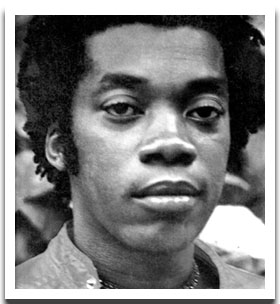 It was 1969. The military was in charge of Brazil and 27-year-old Milton was recording in the United States. He was more than simply homesick. Mr. Nascimento was determined to struggle. So he did the Harriet Tubman: once he got free, he went back south. Way, way south. Down Brazil way. Determined to tough it out. Determined to make a difference. Determined to be a voice.
And he did it, he did it. As noted on NationMaster.com:
It was 1969. The military was in charge of Brazil and 27-year-old Milton was recording in the United States. He was more than simply homesick. Mr. Nascimento was determined to struggle. So he did the Harriet Tubman: once he got free, he went back south. Way, way south. Down Brazil way. Determined to tough it out. Determined to make a difference. Determined to be a voice.
And he did it, he did it. As noted on NationMaster.com:
Nascimento is famous for his chime-clear falsetto and tonal range, as well for highly acclaimed songs such as Maria, Maria, Canção da América (Song from America), Travessia, Bailes da vida and Coração de Estudante (Student's Heart). The lyrics remember the funeral of the student Edson Luís, killed by police officers in 1968. The song became the hymn for the Diretas Já social-politival campaign in 1984 and it was also played in the funeral of the late president Tancredo Neves the next year, who died before assuming the presidency…Although not generally thought of as a political songwriter, Milton Nascimento is the quintessential voice of his people in both a historical and political context.
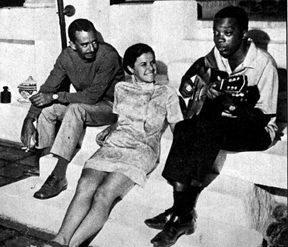 They met and Elis Regina asked to hear Milton’s songs. He sang. She chose to record “Canção do Sal” in 1966. Regina arranged for Milton to secure a feature on Fino da Bossa, a popular Brazilian television program. Offers began to pour in.
In 1967 Agostinho dos Santos entered three of Milton’s songs in the 2nd International Song Festival. “Travessia” took second place and Milton also won as best performer. Later in the year his debut solo album was released. Then came the fortuitous offer to record in the states.
In 1968 Eumir Deodato arranged for Milton Nascimento to journey to the United States and record the album Courage.
Milton Nascimento was doing phenomenally well. He gave it up and returned to Brazil.
They met and Elis Regina asked to hear Milton’s songs. He sang. She chose to record “Canção do Sal” in 1966. Regina arranged for Milton to secure a feature on Fino da Bossa, a popular Brazilian television program. Offers began to pour in.
In 1967 Agostinho dos Santos entered three of Milton’s songs in the 2nd International Song Festival. “Travessia” took second place and Milton also won as best performer. Later in the year his debut solo album was released. Then came the fortuitous offer to record in the states.
In 1968 Eumir Deodato arranged for Milton Nascimento to journey to the United States and record the album Courage.
Milton Nascimento was doing phenomenally well. He gave it up and returned to Brazil.
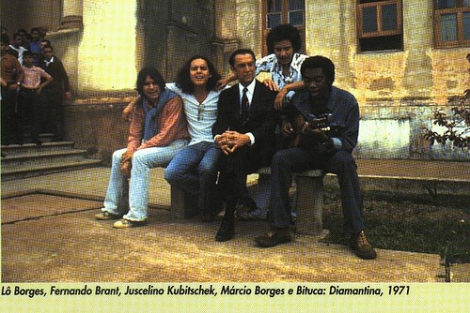 Shortly thereafter in 1971 working with a cabal of cohorts Milton Nascimento produced Clube da Esquina, a 1972 release that completely changed Brazilian music. In the fifties it had been Bossa Nova. In the sixties, Tropicalia. In the seventies it was Clube da Esquina, an approach to sound that was both grounded in Brazilian specifics and simultaneously made extraordinary use of everything current internationally, from the Beatles to jazz.
Today, this music sounds neither trend-setting nor subversive but in Brazil at the dawn of the seventies, Clube da Esquina was a seismic event that for the first time shifted the focus of musical culture from the coastal areas to the hinterlands, from Bahia and Rio to deep in the mountains of Minas Gerais. Imagine how big a shock it would be if we woke up and discovered that both Broadway and Hollywood had moved to Chicago!
Shortly thereafter in 1971 working with a cabal of cohorts Milton Nascimento produced Clube da Esquina, a 1972 release that completely changed Brazilian music. In the fifties it had been Bossa Nova. In the sixties, Tropicalia. In the seventies it was Clube da Esquina, an approach to sound that was both grounded in Brazilian specifics and simultaneously made extraordinary use of everything current internationally, from the Beatles to jazz.
Today, this music sounds neither trend-setting nor subversive but in Brazil at the dawn of the seventies, Clube da Esquina was a seismic event that for the first time shifted the focus of musical culture from the coastal areas to the hinterlands, from Bahia and Rio to deep in the mountains of Minas Gerais. Imagine how big a shock it would be if we woke up and discovered that both Broadway and Hollywood had moved to Chicago!
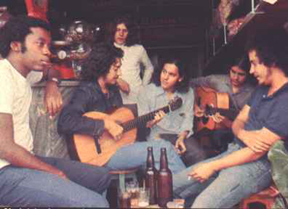 Although they recorded in Rio, the music was the product of a collective from the interior. Milton, the Borges brothers (Marcio and Lo), lyricist and journalist Fernando Brant, Ronaldo Bastos and keyboardist Wagner Tiso were the nucleus of a group of youngsters who had grown up together. Milton was clearly the most talented musician and performer, clearly the most charismatic of the group but he was also generous in sharing the spotlight. Bituca, as his close friends and family called him, even shared the cover credit with Lo Birges, who was still a teenager at the time.
Although they recorded in Rio, the music was the product of a collective from the interior. Milton, the Borges brothers (Marcio and Lo), lyricist and journalist Fernando Brant, Ronaldo Bastos and keyboardist Wagner Tiso were the nucleus of a group of youngsters who had grown up together. Milton was clearly the most talented musician and performer, clearly the most charismatic of the group but he was also generous in sharing the spotlight. Bituca, as his close friends and family called him, even shared the cover credit with Lo Birges, who was still a teenager at the time.
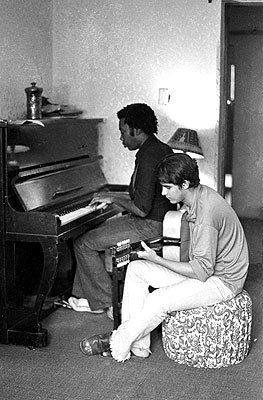 I was friends with Lo’s older brothers; he would hang around us until one day he asked me out for a ‘serious talk.’ He was 12 then. We met at a bar and he explained that he was not a kid and that he had written some songs. Back at the hourse he showed me some stuff and I was totally shocked—the ‘man’ was a damn good composer and singer. From that moment on he was officially part of the gang, and [Clube de Esquina] was basically made by the two of us.
—Milton Nascimento
I was friends with Lo’s older brothers; he would hang around us until one day he asked me out for a ‘serious talk.’ He was 12 then. We met at a bar and he explained that he was not a kid and that he had written some songs. Back at the hourse he showed me some stuff and I was totally shocked—the ‘man’ was a damn good composer and singer. From that moment on he was officially part of the gang, and [Clube de Esquina] was basically made by the two of us.
—Milton Nascimento
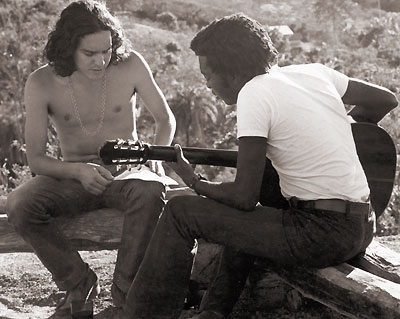 An even greater songwriting partnership was formed with Fernando Brant. Their collaboration has been particularly important in creating MPB (Popular Brazilian Music) classics. It is amazing when you think of how young they were when they started and how they have hung together through the vagaries and changes of adulthood.
They were called Clube de Esquina (Corner Club) because in their formative years they could generally be found hanging out on the corner making their music. There is no analogous grouping of popular musicians in the USA. Unlike Motown they weren’t a business run by a benevolent president. There is nothing else quite like it.
Moreover, six years after the first Clube de Esquina, the guys got back together and released a second double album called Clube de Esquina 2. While it was impossible for the 1978 release to equal its predecessor’s impact because there is no second first time, nevertheless, the second outing with an array of big name guests artists proved to be an important bookend to the decade of the seventies, which is generally considered as Milton’s most musically productive period.
I do both albums and our BoL audience a gross disservice by selecting out a few cuts from the twenty or so songs on each of the two double-albums. Part of the impact of each production was in its wide ranging diversity, songs of different styles but generally all of high quality, and how those diverse compositions synergistically interacted with each other.
Like everyone I have my favorites—indeed, some of the songs are favorites as songs even though I prefer other versions, but Clube de Esquina 1 & 2 were the beginnings and that is part of their importance. The two albums set standards for MPB.
An even greater songwriting partnership was formed with Fernando Brant. Their collaboration has been particularly important in creating MPB (Popular Brazilian Music) classics. It is amazing when you think of how young they were when they started and how they have hung together through the vagaries and changes of adulthood.
They were called Clube de Esquina (Corner Club) because in their formative years they could generally be found hanging out on the corner making their music. There is no analogous grouping of popular musicians in the USA. Unlike Motown they weren’t a business run by a benevolent president. There is nothing else quite like it.
Moreover, six years after the first Clube de Esquina, the guys got back together and released a second double album called Clube de Esquina 2. While it was impossible for the 1978 release to equal its predecessor’s impact because there is no second first time, nevertheless, the second outing with an array of big name guests artists proved to be an important bookend to the decade of the seventies, which is generally considered as Milton’s most musically productive period.
I do both albums and our BoL audience a gross disservice by selecting out a few cuts from the twenty or so songs on each of the two double-albums. Part of the impact of each production was in its wide ranging diversity, songs of different styles but generally all of high quality, and how those diverse compositions synergistically interacted with each other.
Like everyone I have my favorites—indeed, some of the songs are favorites as songs even though I prefer other versions, but Clube de Esquina 1 & 2 were the beginnings and that is part of their importance. The two albums set standards for MPB.
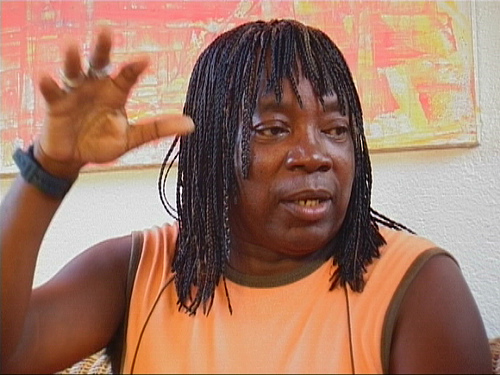 Milton Nascimento has established a formal business to take control of his music and as a result, over thirty years later there is a recent release of two extremely important pieces of work: Maria Maria/Ultimo Trem. It’s a double CD set and absolutely essential for anyone who loves the music and singing of Milton Nascimento.
I find these two ballet scores even more impressive than Clube de Esquina in terms of offering us the Brazilian depth of Nascimento’s music. I quote the liner notes:
Milton Nascimento has established a formal business to take control of his music and as a result, over thirty years later there is a recent release of two extremely important pieces of work: Maria Maria/Ultimo Trem. It’s a double CD set and absolutely essential for anyone who loves the music and singing of Milton Nascimento.
I find these two ballet scores even more impressive than Clube de Esquina in terms of offering us the Brazilian depth of Nascimento’s music. I quote the liner notes:
In 1976, Milton and Brant teamed up with a new contemporary dance company called Grupo Corpo, whose Argentinian choreographer Oscar Araiz, would become a collaborator with the two musicians. Together, they conceived a show based on the composite life story of the daughter of a black slave called Maria. Nascimento wrote music to Brant’s lyrics and “Maria Maria” was premiered in the main theatre of the Belo Horizonte Palacio des Artes that year. “Fernando wrote the lyrics for the ballet, but there were originally no lyrics for the theme song, ‘Maria Maria’.“ Milton and Feernando worked on the lyrics together, basing them on folk stories about the black women of the countryside. Adds Milton, “These memories are mostly things that we witnessed—Fernando and I—rather than whaat we experienced ourselves. …Relying on songs without lyrics as well a evocative vocalizing and choruses, Milton experimented heavily with Afro-Brazilian percussion and taped jungle sounds… ‘Maria Maria’ was performed by an impressive group of young musicians who are today household names in Brazilian music, including Nana Vasconcelos (percussion and effects), Torinho Horta (guitars) and Paulo Moura (sax). Several vocalists including Nana Caymmi, Fafa de Belem, Beto Guedes, and Milton himself, had hits in years to come with reworkings of these songs. With the success of ‘Maria Maria’ behind them the team reunited in 1980 to produce another ballet, ‘Ultimo Trem (Last Train)’. This time, they chose to tackle a more contemporarily relevant subject, the impact of the closure of a train line that connected certain towns and cities in the North East of Minas Gerais to the coast. “The military government shut down the route and the whole region began to fade away,” explains Milton. …The ballet brought great media attention to the campaign against closure. “Most of Fernando’s lyrics have some political tone,” says Milton. “This one helped the area a lot because the politicians grew concerned about the subject.” …Fernando’s and Milton’s shared passion for the sounds, smells and memories of trains, inspired the soundtrack for the production premiered in 1980… The closing track ‘Ponta de Areia (Sand Edge)’, was based on one of Fernando’s newspaper stories and became one of Milton’s most famous pieces, covered by musicians across the planet, including Wayne Shorter and Earth, Wind and Fire. The soundtrack to two ballets that dealt with the legacy of slavery in Brazil (Maria Maria) and the closure of one of Brazil’s most important railroads (Ultimo Trem/Last Train) these CDs feature legendary Brazilian musicians Nana Vasconchellos, Nana Caymmi, Fafa de Belem, Zeze Motta, Paulinho Jobim and former members of Milton's Som Imaginario band. The music on these CDs is raw, atmospheric and emotionally charged – bursting with ideas and experimentation it reveals a songwriter at his creative peak and one of the most important artists from Brazil.
* * *
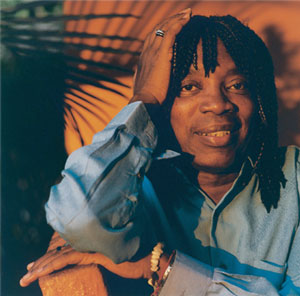 In the jukebox the first five tracks are from Clube da Esquina (1972): “Tudo que voca podia ser,” “Cais,” “O trem azul,” “Clube da Esquina no 2,” and “Os povos.”
The next six tracks are from Maria Maria (1976): “Santos Catolicos X Candomble,” “Cozinha,” “Pilar,” “Seducao,” “Eu Sou Uma Preta Velha Aqui Sentada no Sol,” and “Maria Maria”
We follow with four tracks from Clube da Esquina 2 (1978): “O Que Foi Feito Devera o Que Foi Feito de Vera,” “Misterios,” “Reis e Reainhas do Maracat,” and “Meu Menino.”
The Nascimento section continues with three tracks from Ultimo Trem (1980): “Saidas e Bandeiras,” “Itamarandiba” and “Ponta de Areia (Epilogo).”
The Nascimento section concludes with two covers of “San Vicente” that feature Milton singing.
Although this is not how I got into Milton’s music, and is not necessarily my personal favorites, nevertheless, I do believe this gives the best brief overview and understanding of the importance of Milton’s contribution to Brazilian music.
It is significant that all of this music was recorded under the heavy censorship of a military dictatorship. We often talk about the golden period of Black music being the sixties and seventies, many of us don’t realize that there is a global significance for people of color struggling through the sixties and the seventies. Whether Africa, the Caribbean or the Americas, the music produced during these two decades represents a high point in the total history of world musical culture.
In the jukebox the first five tracks are from Clube da Esquina (1972): “Tudo que voca podia ser,” “Cais,” “O trem azul,” “Clube da Esquina no 2,” and “Os povos.”
The next six tracks are from Maria Maria (1976): “Santos Catolicos X Candomble,” “Cozinha,” “Pilar,” “Seducao,” “Eu Sou Uma Preta Velha Aqui Sentada no Sol,” and “Maria Maria”
We follow with four tracks from Clube da Esquina 2 (1978): “O Que Foi Feito Devera o Que Foi Feito de Vera,” “Misterios,” “Reis e Reainhas do Maracat,” and “Meu Menino.”
The Nascimento section continues with three tracks from Ultimo Trem (1980): “Saidas e Bandeiras,” “Itamarandiba” and “Ponta de Areia (Epilogo).”
The Nascimento section concludes with two covers of “San Vicente” that feature Milton singing.
Although this is not how I got into Milton’s music, and is not necessarily my personal favorites, nevertheless, I do believe this gives the best brief overview and understanding of the importance of Milton’s contribution to Brazilian music.
It is significant that all of this music was recorded under the heavy censorship of a military dictatorship. We often talk about the golden period of Black music being the sixties and seventies, many of us don’t realize that there is a global significance for people of color struggling through the sixties and the seventies. Whether Africa, the Caribbean or the Americas, the music produced during these two decades represents a high point in the total history of world musical culture.
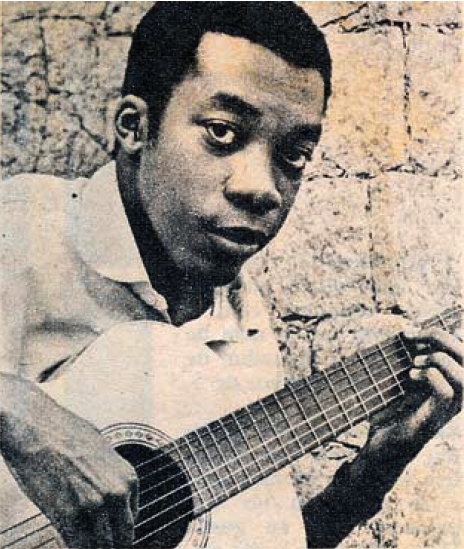
In my hometown, when I was a boy—Tres Pontas, in the state of Minas Gerais—we listened to all kinds of music and there was no distinction; we listened to everything from rock-and-roll to classical music to music from Latin America. We just listened to everything at any time. My mother, when she was young, used to sing in a choir conducted by [Brazilian classical composer] Villa-Lobos. My father enjoyed a different kind of classical music, and I used to listen to a lot of movie soundtracks and jazz, but I was always very in tune to the folk music around my town. When I left my small town, I left with my own thing already. I come from a very small place where it was very difficult to get what the major urban centers were doing. So when I reached the main cities, like Rio and Sao Paulo, tropicalismo was already happening. I was arriving with something of my own, something different. The fact that I always brought my own different thing has, in a way, always set me aside from the main media revolution. —Milton Nascimento I used to play with my friends in the mountains. We were all together and one of us screamed and the echo came back, so we started to play with it, building on the voices and even today on my recordings I like to build a design with many different voices. —Milton NascimentoIt may take a third, fourth or fifth listen to really get to Milton’s music but it is supremely and sublimely worth the effort. Milton Nascimento is one of the greatest voices and composers of all time. We are blessed to share time and space with this profound musical reverberation of the essence of our humanity. —Kalamu ya Salaam
Profoundly meaningful Milton definitely does have his own sound. I don't know much about the history of Brazilian music, but I do listen to a lot of it. Usually, the musicians I like play samba or bossa nova. Or, they play MPB that has elements of samba or bossa nova. As some of Milton's quotes make clear, he wasn't part of the big city scenes and he developed his style independently. He's not always an easy musician to "get" though. Some of his music I really, really like (most of the original Clube da Esquina album, for example); a lot of it though, I'm forced to admire without actually enjoying it. I wasn't surprised to learn that there was classical music in his background - you can hear it sometimes. Probably the best (or at least, my favorite) element of Milton's music is the way he layers voices or uses his voice in unorthodox ways melodically. Sometimes it sounds like his own voice via multi-tracking, sometimes it's obviously other singers joining him, but either way, he uses voices in a unique way. At times, it almost sounds like he's writing for a string quartet, except, instead of strings, he's using voices. This effect is especially notable on his wordless "sound songs." The title track of Clube da Esquina is one of several examples. Another is "Maria Maria" - it's way too short, but how pretty is that? I love it when Milton does the half-humming, half-scatting thing. He's not saying anything (in the literal sense) and even if he was, I wouldn't be able to understand him, but somehow the sounds he makes are still profoundly meaningful. It's very hard to explain, but that's Milton. :-) —Mtume ya Salaam
This entry was posted on Monday, August 11th, 2008 at 2:31 am and is filed under Classic. You can follow any responses to this entry through the RSS 2.0 feed. You can leave a response, or trackback from your own site.
2 Responses to “MILTON NASCIMENTO / “Ponta De Areia (Epílogo)””
November 18th, 2013 at 8:09 pm
I love Milton’s music! Great article! My wife says that I was born in the wrong country ( we are from Dominican Republic)
February 22nd, 2015 at 4:55 am
really enjoyable article. thank you for taking the time to research and write it, so that others can know about his life and be inspired. he is one of my favourite composers. his music is so personal and hauntingly beautiful.
Leave a Reply
| top |